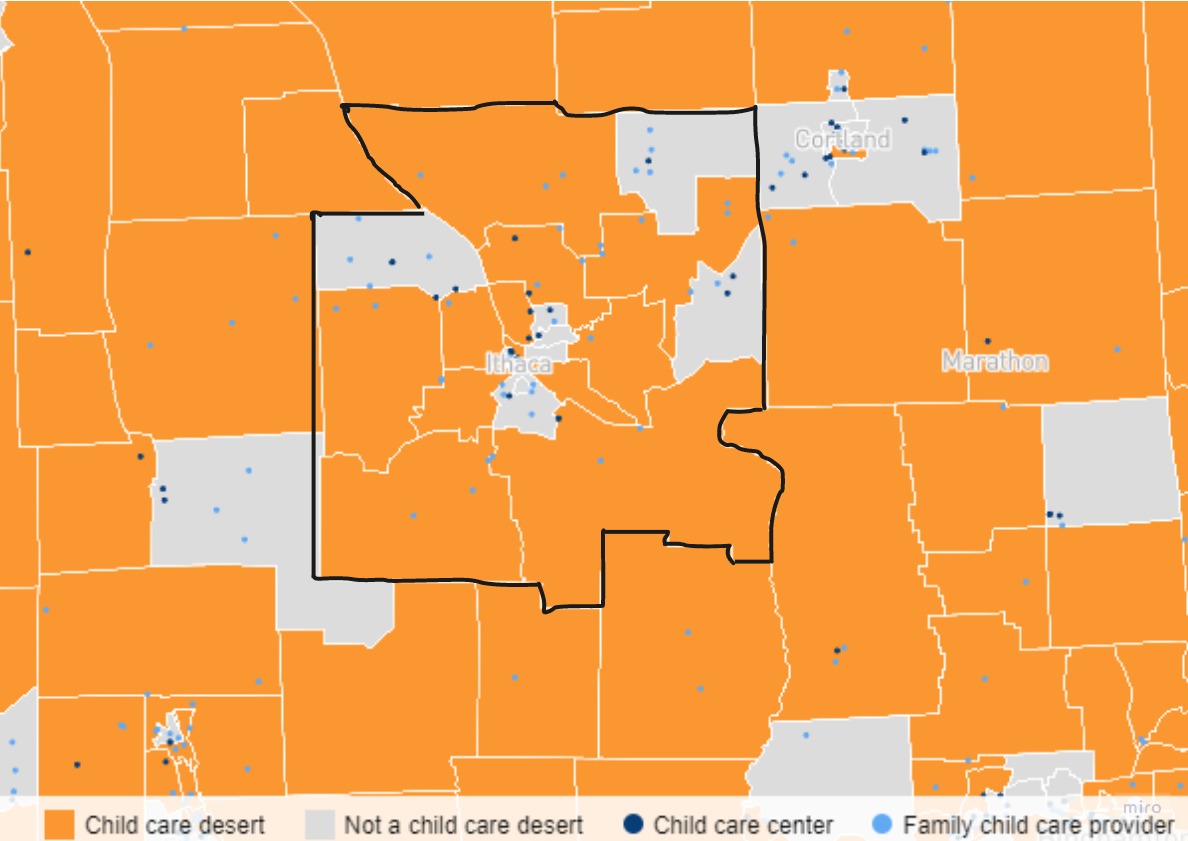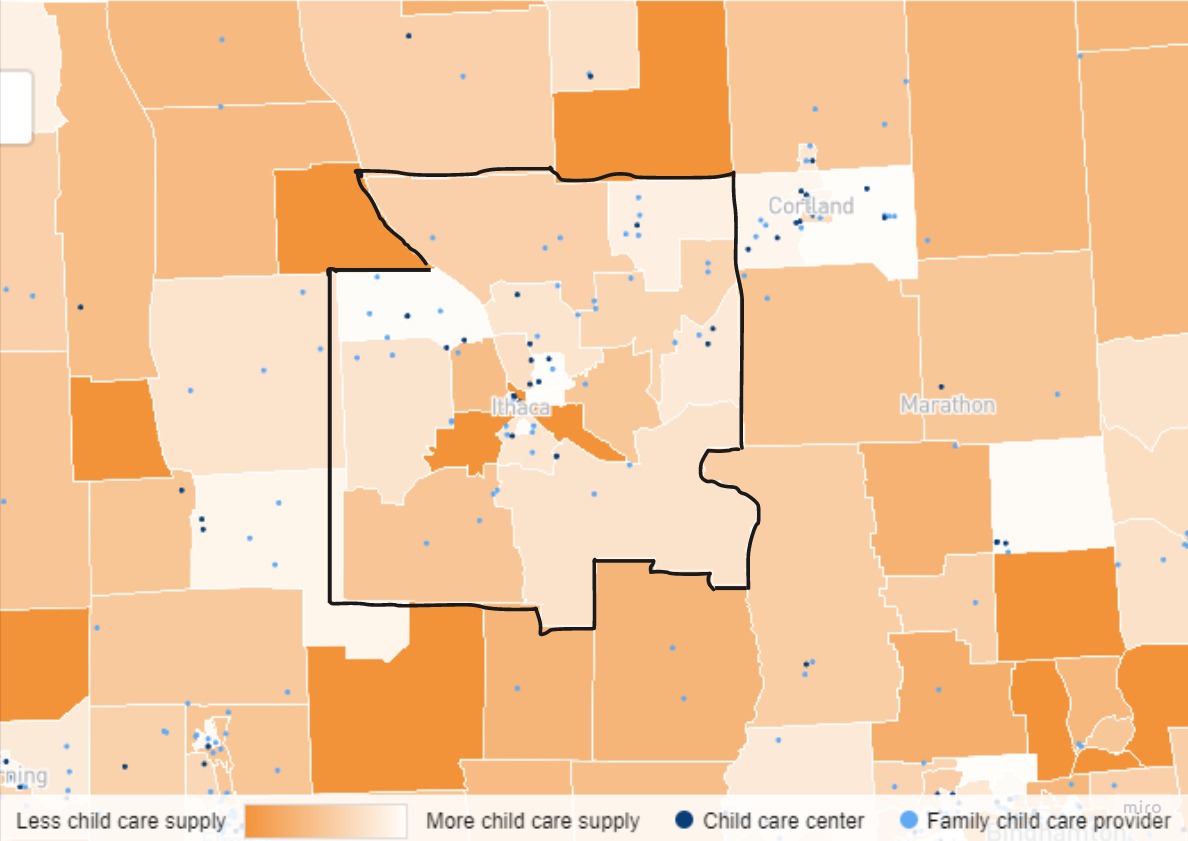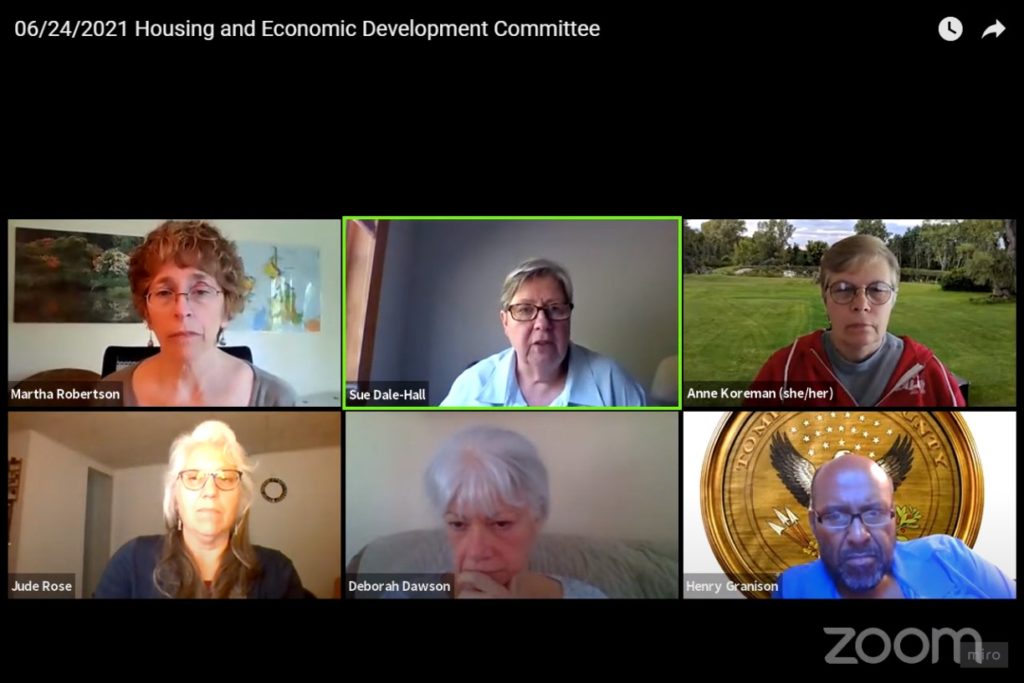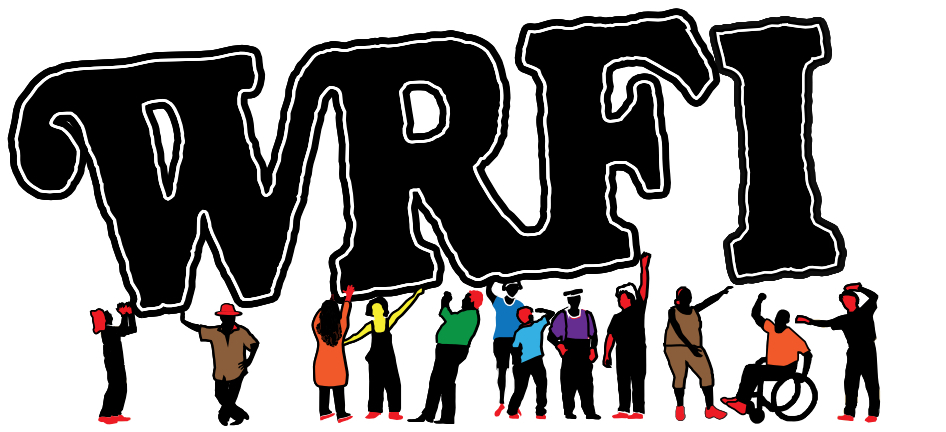Tompkins County is a Childcare Desert

Deserts vs. Non Deserts in Tompkins County. From the Center for American Progress.

Tompkins County's Desert Score. Desert Score score measures how many children there are relative to licensed child care slots. From the Center for American Progress.
TOMPKINS COUNTY, NY -- Much of Tompkins County is considered a Childcare Desert. That’s according to the Center for American Progress.
The childcare shortage is a well known and documented issue in the county, but now the County Legislature has a unique opportunity to help address the problem. They could use a portion of the $19.8 million it received from the American Rescue Plan Act (ARPA).
The ARPA money has less restrictions than the county’s normal sources of revenue, allowing the Legislature to put it directly in the pockets of small businesses impacted by the COVID-19 pandemic, or essential works. The money is meant to spur the County’s economic recovery from the pandemic which, if you ask Sue Dale-Hall, is a strong rationale for funding child care projects in the county.
Dale-Hall is the CEO of the Child Development Council, a non-profit focused on issues of child and family well-being in Cortland and Tompkins Counties.
A lack of access to affordable childcare is one theory to explain why unemployment rates, nationally and locally, haven’t returned to pre-pandemic levels.
This is a theory that’s moving federal funds. New York state was allocated $2.4 billion to be expressly used to support families with children and childcare providers. On June 23rd, Governor Cuomo announced $25 million that will support essential workers with childcare as the economy reopens.
And there appears to be a consensus among County Legislators that affordable and more childcare is key, not only for getting parents back into the workforce, but for future economic development.
At the Legislature’s Housing and Economic Development Committee meeting on June 24th, Dale-Hall distilled the county’s child care shortage down to facts and figures for county officials.

Sue Dale-Hall, CEO of the Child Development Council, presents to the County Legislature about Childcare in Tompkins County at June 24th's, Housing and Economic Development Committee Meeting
The Child Development Council found that in Tompkins County, when regulated child care centers are at capacity, they can only provide access to one in three or one in four children, depending on their age group.
Dale-Hall said that’s about average for New York state. Though, that isn’t a standard worth bragging about. What’s scarce is often not cheap.
According to the Economic Policy Institute, the average cost of childcare in New York for a 4 year old is over $12 thousand dollars a year. The average cost for an infant is over $15 thousand dollars a year.
Dale-Hall said these prices closely match the cost of care in Tompkins County.
In 2018, the national non-profit, Child Care Aware of America (CCAoA), ranked New York as the 9th least affordable state for center-based care infant care; the 8th least affordable for 4-year-olds; and the 6th least affordable for toddlers.
To try to combat the high cost of childcare and it’s low availability in Tompkins County, the Child Development Council enrolls people to provide informal childcare.
An informal provider can be an in-home nanny, but is often characterized as a family, friend, or neighbors who offers home-based childcare. These providers are subject to lighter rules and regulations than regulated childcare providers.
Families who use informal providers may be able to pay them through subsidies administered by the Department of Social Services (DSS). In Tompkins County, a parent is eligible for informal child care subsidies if they are below 200% of the federal poverty rate. For a family of four, that means their income would have to be below $53,000.
In addition to financial criteria, a family's eligibility for subsidized care is determined by activities they need childcare for, like work or school that can occupy time that would otherwise be used caring for their children.
Although informal providers could buoy available and affordable childcare in need in Tompkins County, people just aren’t enrolling.
In 2017, total informal childcare providers in Tompkins County tallied up to 135; then 55 in 2019; and just 19 in 2020.
Unless an informal provider is enrolled, they can’t receive the subsidy money that qualified families can receive from DSS.
While the Child Development Council continues to push for people to enroll as informal providers and spread the word on DSS subsidies, the Legislature will likely look for solutions in the realm of regulated child care centers.
Sue Dale-Hall raised four current projects that the Legislature could assist through an allocation of ARPA funding. The projects are all expansions, happening at different not-for-profit regulated childcare centers: Ithaca Community Childcare Center (IC3); the Ithaca YMCA; the Ithaca Children’s Garden; and the Coddington Road Childcare Center.
All these organizations have received funding for their projects from the Southern Tier Regional Economic Development Council (REDC). But the catch is that this funding from the REDC only covers about 20 percent of each overall project budget. The rest of that cost will have to be raised or financed by each childcare center.
The IC3 project has already been fully financed and is underway. For that project, and the others trying to finance, there are added operational costs that may very well be passed onto parents. In addition, childcare is a business with notoriously thin profit margins, making financing a risky venture for all of these organizations.
Reducing the cost of care for parents, and mitigating the risk that an existing childcare center may face financial uncertainty, are both reasons why the Legislature may choose to fund these projects. Luckily, Tompkins County did not see any providers go under during the pandemic, but financial stress is to be expected at all these organizations.
But maybe the biggest motivation for funding the expansion of existing not-for-profit childcare, are the parameters of how the ARPA funding must be spent.
It’s one time-money that needs to be obligated to a spending plan by December, 31st, 2024, then be fully spent before January, 2027. This short time frame for executing a spending plan doesn’t favor a use like providing subsidies for families.
Legislator Deborah Dawson is one of the county representatives that is interested in investing into childcare. Though, at last week's committee meeting she expressed caution for how this one time ARPA money might be used. She acknowledged that there is a lot of need that can be met with the money, especially after the pandemic, but that it’s only $19.8 million.
After Dale-Hall presented the opportunities the County has to invest in not-for-profit childcare projects, Dawson agreed that there was potential in for to invest in one or some of the projects, but said, “I think it's important for the legislature as a whole, when it's making these allocations, to understand what the minimum amount of money would be that would truly have an impact.”
That minimum number has not yet been determined.
The Legislature will be discussing how to allocate it’s ARPA funding at tonight’s Expanded Budget, Capital, and Personnel Committee meeting.
